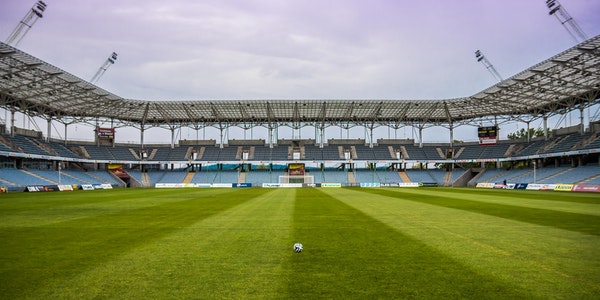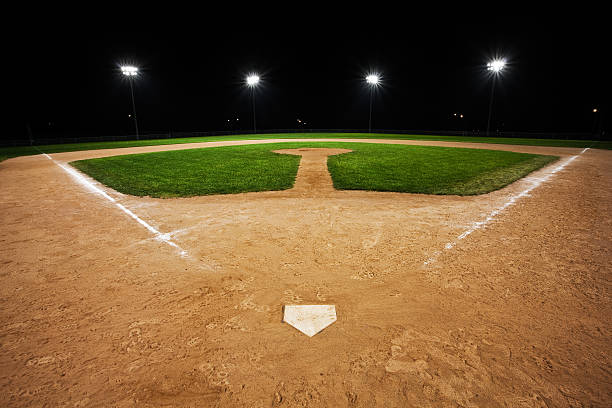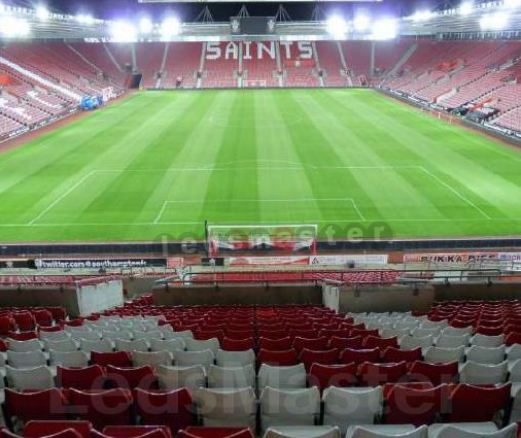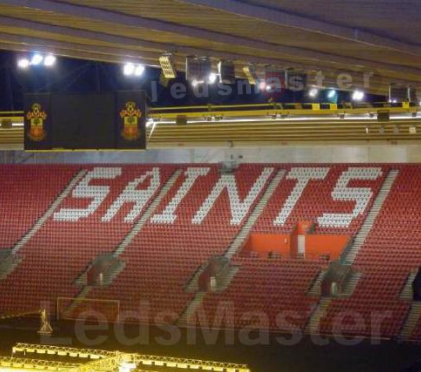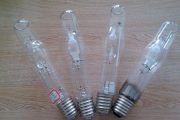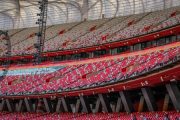I. Introduction
A. Overview of the shift to LED lighting in major stadiums
The shift to LED lighting in major stadiums represents a significant advancement in sports venue technology. Traditionally, these stadiums relied on conventional lighting systems, such as metal halide or high-pressure sodium lamps. However, with the emergence of LED technology, stadiums around the world are transitioning to LED lighting for several compelling reasons.
LED lighting offers numerous advantages over traditional lighting systems. It provides superior brightness, color rendering, and visibility, enhancing the overall sports viewing experience for both players and spectators. Additionally, LED fixtures are highly energy-efficient, leading to substantial cost savings in terms of electricity consumption and maintenance expenses. The longevity and durability of LED lights further contribute to reduced operational costs and enhanced reliability.
Furthermore, LED lighting allows for greater flexibility and customization, enabling stadiums to adjust lighting levels and create dynamic visual effects tailored to different events and occasions. This versatility enhances the ambiance and atmosphere of the stadium, contributing to a more immersive and enjoyable experience for fans.
Overall, the shift to LED lighting in major stadiums represents a significant step forward in stadium technology, offering improved performance, energy efficiency, and versatility while reducing environmental impact and operational costs.
B. Importance of enhancing the sports viewing experience
Enhancing the sports viewing experience is of paramount importance for several key reasons:
- Fan Engagement: A captivating and enjoyable viewing experience keeps fans engaged and connected to the game or event. This engagement fosters loyalty, strengthens the fan base, and contributes to increased attendance, viewership, and revenue for sports organizations.
- Competitive Advantage: Stadiums and teams that prioritize the viewing experience gain a competitive edge. They attract top talent, secure lucrative sponsorship deals, and maintain a strong position in the sports industry, both domestically and internationally.
- Revenue Generation: A positive viewing experience encourages fans to spend more on tickets, merchandise, concessions, and premium amenities. It also attracts corporate partners and advertisers eager to associate their brands with a captivating sports atmosphere.
- Brand Image: Exceptional viewing experiences elevate the brand image of sports franchises, stadiums, and leagues. They become recognized for providing top-tier entertainment and hospitality, enhancing their reputation and influence in the sports community.
- Community Building: Sports have the power to bring people together, fostering a sense of unity and belonging within communities. By enhancing the viewing experience, stadiums create shared spaces where fans can celebrate victories, share emotions, and build lasting connections with fellow supporters.
- Global Appeal: A compelling viewing experience transcends geographical boundaries, attracting fans from around the world. This global appeal broadens the reach of sports organizations, increasing their international fan base, media exposure, and commercial opportunities.
- Player Performance: A well-designed and immersive viewing environment can positively impact player performance. Players thrive in atmospheres where they feel supported and energized by the excitement of the crowd, ultimately elevating the quality of competition on the field or court.
In conclusion, enhancing the sports viewing experience is essential for driving fan engagement, generating revenue, building brand equity, fostering community cohesion, expanding global reach, and optimizing player performance. It represents an investment in the future success and sustainability of sports organizations and the industry as a whole.
II. Benefits of LED Lighting in Stadiums
A. Improved visibility for players and spectators
Improved visibility for both players and spectators is crucial for several reasons:
- Safety: Clear visibility ensures that players can accurately perceive their surroundings, reducing the risk of collisions, injuries, or accidents during gameplay. It also enables referees and officials to make accurate calls, maintaining fairness and integrity in sports competitions.
- Performance: Optimal visibility allows players to track the ball, anticipate movements, and make split-second decisions with precision. This enhances the quality of gameplay and enables athletes to showcase their skills to the fullest extent.
- Fan Experience: Spectators attend sporting events to witness the action up close and immerse themselves in the excitement of the game. Improved visibility ensures that fans can follow the action on the field or court with clarity, enhancing their overall enjoyment and engagement.
- Broadcast Quality: Clear visibility is essential for high-definition television broadcasts and live streams. Enhanced visibility ensures that viewers at home have a clear and immersive viewing experience, making the broadcast more appealing and enjoyable.
- Atmosphere: A well-lit stadium enhances the overall atmosphere of the sporting event, creating a sense of excitement and energy among spectators. Improved visibility allows fans to see facial expressions, gestures, and other nuances of the game, enhancing their emotional connection to the event.
- Accessibility: Enhanced visibility benefits individuals with visual impairments or disabilities, allowing them to better follow the action and participate in the sports experience. This promotes inclusivity and ensures that everyone can enjoy sports events to the fullest extent possible.
In summary, improved visibility for players and spectators is essential for safety, performance, fan experience, broadcast quality, atmosphere, and accessibility. It contributes to the overall success and enjoyment of sports events, enhancing the experience for all involved.
B. Enhanced color rendering for better broadcast quality
Enhanced color rendering in sports broadcasting is crucial for delivering a high-quality viewing experience to audiences. Here’s why it’s important:
- Visual Clarity: Accurate color rendering ensures that viewers can see the true colors of team uniforms, equipment, and the playing field. This clarity enhances the overall visual experience, making it easier for audiences to follow the action and engage with the game.
- Atmosphere and Ambiance: True-to-life colors contribute to the atmosphere and ambiance of the sporting event. Whether it’s the vibrant hues of team logos or the lush green of the playing surface, accurate color rendering helps recreate the excitement and energy of being at the stadium.
- Branding and Sponsorship: Sports broadcasts often feature branding elements and sponsor logos displayed throughout the venue. Enhanced color rendering ensures that these logos are accurately represented, maintaining brand consistency and maximizing the visibility and impact of sponsors.
- Viewer Engagement: High-quality visuals are essential for capturing and retaining viewer attention. Enhanced color rendering makes the broadcast more visually appealing, increasing viewer engagement and immersion in the game.
- Reproduction of Emotions: Accurate color representation allows viewers to see the emotions and expressions of players, coaches, and fans more vividly. This adds depth and authenticity to the broadcast, enhancing the storytelling aspect of sports coverage.
- Competitive Advantage: Broadcasters that prioritize color accuracy gain a competitive edge in the industry. Viewers are more likely to tune in to broadcasts that offer superior visual quality, leading to higher ratings and increased advertising revenue.
- Viewer Satisfaction: Ultimately, enhanced color rendering contributes to overall viewer satisfaction. By delivering a visually stunning and true-to-life broadcast, broadcasters can leave a lasting impression on audiences and build loyalty over time.
In summary, enhanced color rendering is essential for better broadcast quality in sports coverage. It improves visual clarity, contributes to the atmosphere of the event, maximizes branding opportunities, increases viewer engagement, provides a competitive advantage, and ultimately leads to higher viewer satisfaction.
C. Energy efficiency and cost savings
Energy efficiency and cost savings are significant benefits of LED lighting in sports stadiums, contributing to their widespread adoption. Here’s why they matter:
- Reduced Energy Consumption: LED lighting fixtures are highly energy-efficient compared to traditional lighting technologies like metal halide or high-pressure sodium lamps. LEDs convert a higher percentage of energy into visible light, resulting in lower electricity consumption. This reduces the environmental impact of the stadium and lowers utility bills.
- Longer Lifespan: LED fixtures have a much longer lifespan compared to conventional lighting sources. They typically last tens of thousands of hours, significantly reducing the frequency of lamp replacements and associated maintenance costs. This not only saves on replacement expenses but also reduces labor costs and downtime for maintenance activities.
- Lower Maintenance Costs: With fewer lamp replacements and maintenance requirements, LED lighting systems offer substantial long-term cost savings. Stadiums can allocate resources more efficiently, focusing on other areas of facility upkeep or investing in additional amenities to enhance the fan experience.
- Financial Viability: While LED lighting systems may have higher upfront costs compared to traditional lighting technologies, the long-term cost savings outweigh the initial investment. Energy savings, reduced maintenance expenses, and potential rebates or incentives for energy-efficient upgrades make LED lighting financially viable for stadiums over time.
- Operational Efficiency: LED lighting systems often come with advanced control features, allowing stadiums to adjust lighting levels, schedules, and zoning according to specific needs. This enhances operational efficiency and flexibility, enabling stadiums to optimize energy usage based on event schedules, occupancy levels, and other factors.
- Sustainability Benefits: By reducing energy consumption and greenhouse gas emissions, LED lighting contributes to a more sustainable and environmentally friendly stadium operation. This aligns with corporate sustainability goals, enhances the stadium’s reputation as a responsible steward of resources, and appeals to environmentally conscious fans, sponsors, and stakeholders.
In summary, energy efficiency and cost savings are compelling reasons for stadiums to transition to LED lighting. They offer reduced energy consumption, lower maintenance costs, improved operational efficiency, and sustainability benefits, ultimately providing a positive return on investment and contributing to the long-term financial and environmental sustainability of sports venues.
D. Customizable lighting effects for special events and entertainment
Customizable lighting effects in sports stadiums offer numerous advantages for special events and entertainment, enhancing the overall experience in several ways:
- Dynamic Atmosphere: Customizable lighting allows stadiums to create dynamic atmospheres tailored to different events, such as concerts, exhibitions, or ceremonies. By adjusting colors, intensity, and patterns, stadiums can transform their ambiance to suit the mood and theme of the occasion, enhancing the overall experience for attendees.
- Enhanced Entertainment Value: Lighting effects add to the entertainment value of events, captivating audiences and creating memorable experiences. Choreographed light shows synchronized with music or performances can elevate the entertainment factor, leaving a lasting impression on attendees and enhancing the event’s appeal.
(To Be Continued)

